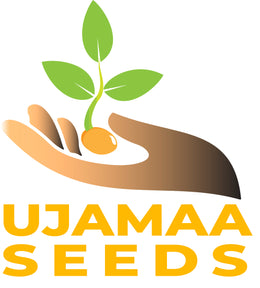Lottie Collards
Brassica oleracea
Seeds per pack ~ 100
Germination: 80% Oct 2024 (Packed for 2025)
Collards, or collard greens, are probably the most culturally important crop for African Americans, as well as many who trace their roots to the American South . They're essentially open-headed cabbages (Brassica oleracea), with broad, smooth, almost waxy (and sometimes glossy) leaves that vary from green to blue-green to green-purple. While they have long been closely associated with Black culture in the US — a staple green in traditional Southern Black foodways, and consequently popular in Black communities across the country — the plant actually has its origins in Europe and the Mediterranean. It is generally considered the most cold-hardy of the cabbages (which also include broccoli, cauliflower, Brussels sprouts, kale, and kohlrabi).
HISTORY: Collard greens hold an important place in the history of the descendants of enslaved Africans. Grown in western Africa and often served with fried chickens, the collard green was often cooked with pork parts unwanted by the slave owners. Since the enslaved people were not often given time to cook for themselves, collard greens’ need for a long cooking period made it an ideal dish for Sundays and holidays. This particular collard variety holds a fascinating story. It is said to bear the name of the woman who was enslaved, who was its caretaker, and was considered an extinct variety until it was successfully grown by Jeffery “Mr. Mac” McPherson at the Lumberton Correctional Institute in North Carolina.
DAYS TO MATURITY: Between 70-90, but tastes best when leaves are harvested before maturity.
NUTRITIONAL VALUE: Collards are high in dietary fiber (feeding the beneficial gut bacteria), calcium, iron, magnesium, Vitamins A, K, B-6, & C. Collards are known to lower cholesterol, be a cancer-fighter (high in glucosinolates), and even improves sleep.
FOOD PREP: There are many recipes for collards that have been passed down for generations. It is often cooked on a stovetop with water and either ham or smoked turkey and seasonings. It can also be sauteed, or braised (with apple cider vinegar for a great flavor!).
GROWING TIPS: Biennial. First, you'll need to select a spot in your garden with plenty of sunlight and soil with plenty of nutrients. Prepare the soil by removing weeds, and incorporating compost or fertilizer to improve soil fertility. Next, sow the seeds directly in the soil, spaced about 8 inches apart, or you can start the seeds indoors and transplant them later. Water your collards regularly, ensuring the soil is moist but not saturated. As the plants grow, you'll want to thin out the seedlings to ensure they have enough space to reach their full potential. You may also want to add a layer of mulch to help keep the soil moist and to reduce weeds. These greens are winter-hardy and sweeten a bit with a touch of frost. *See Greens Growing Guide for more information




